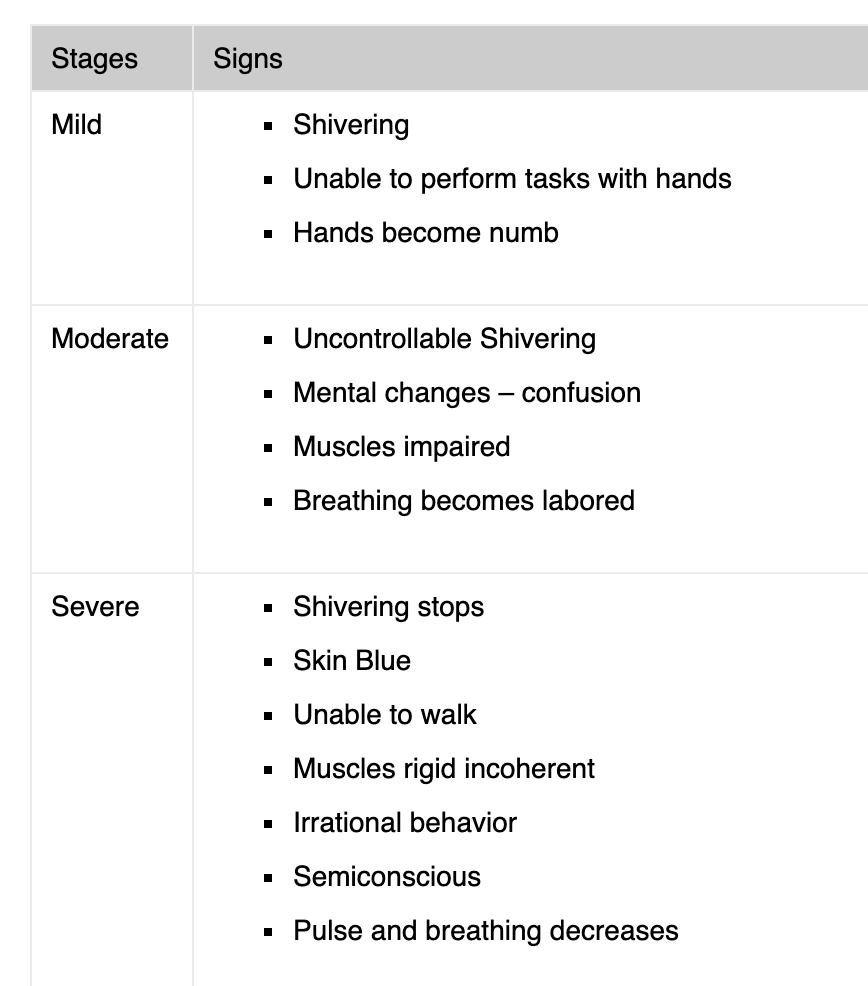Why are people found in the backcountry with their clothes missing?
Hikers are often found in the wilderness, missing clothing or their boots despite freezing temperatures. What causes these people to strip naked or burrow into foliage when they are on the verge of freezing to death? Why do they often have a contented look just before freezing to death?
What is Hypothermia?
Hikers can often succumb to the cold weather and develop Hypothermia, where the core body temperature drops below 35.0 °C (95.0 °F). When this happens, your heart, nervous system, and other organs stop functioning normally and eventually shut down. In contrast, hyperthermia is the opposite condition, where the body overheats.
While most people think of hypothermia as something that only happens in the winter, it’s common to see hikers suffer from this condition throughout the year, even in the summer, especially when caught in a rainstorm or after falling into the water.
When in the backcountry, it’s not uncommon for the temperature to drop 20-40 degrees at night. Once those nighttime temperatures drop, a hiker wet from rain and sweat from exertion can be quickly affected by hypothermia. Before they know it, they’re in trouble.
There are four stages of hypothermia:
Hypothermia can be exacerbated by external factors, such as alcohol and psychoactive drugs, clothing which isn’t warm enough for the circumstances, and wetness. Important internal factors in young and middle-aged hikers are leanness (lack of fat), physical exhaustion, and trauma. In older or elderly people, illness and degeneration of natural heat conserving and production responses can deteriorate.
When someone falls into a river or stream and perhaps immersed in cold or freezing water, death occurs rapidly as the muscles and breathing seize up, and death occurs frequently from drowning.
The face, feet and hands have purple areas or spots for victims of dry frost or snow. Stress ulcerations or hemorrhages in the stomach lining develop in around 70% of cases.
In long-lasting exposures to cold temperature, hemorrhagic pancreatitis (bleeding within or around the pancreas), lung edema (water on the lungs), and myxomatous skin edema ('mucus' or 'slimy substance on the skin) have been the characteristic signs.
What is paradoxical undressing?
Twenty to fifty per cent of hypothermia deaths are linked to a phenomenon called “paradoxical undressing”. During moderate and severe hypothermia, this typically occurs when the core body temperature drops below 32.0 °C (90 °F).
The person becomes disoriented and confused, and then, they strangely begin taking off their clothing despite the fact they are on the verge of freezing to death. Just before people become unconscious, they have a feeling of warmth flushing over their bodies, and they feel uncomfortably hot.
As they take off their clothing, their temperature drops even further. It often represents the last effort of the victim and is followed almost immediately by unconsciousness and death. The clothes of the bodies are discarded on the ground in front of the final position, sometimes forming a trail. Sometimes, rescuers incorrectly assume that victims have been the subject of a sexual assault as a result.
What does the body look like after Paradoxical undressing?
The most frequent findings at autopsy are purple spots or discoloration on the extremities, pulmonary edema (water on the lungs), and gastric hemorrhages (blood and fluids in the gut).
What causes paradoxical undressing?
It is thought that the cold causes a malfunction of the part of the brain called the hypothalamus that regulates body temperature. Another explanation is that the muscles which contract blood vessels on the outer parts of the body become exhausted, a condition known as a loss of vasomotor tone and relaxation, leading to a sudden surge of blood (and heat) to the extremities, causing the person to feel overheated.
What is Terminal Burrowing?
A hypothermia-induced behavior is known as self-protective “terminal burrowing”, which occurs in the final stage of hypothermia, often after paradoxical undressing. Hikers will seek out shelter by seeking shelter under logs, leaves, and other foliage.
In most cases, the final position in which the bodies are found could only be reached by crawling on all fours or flat on the body, resulting in damage to the knees and elbows.
How to prevent and treat Hypothermia
Try and avoid getting wet through. Dry off as soon as possible when you get wet, especially when the outside temperature drops in the evening. If you have been sweaty after hiking, dry off or change into a dry pair of clothes. Don’t get into your sleeping bag or tent wet.
Keep drinking water and eat. Hikers always focus on drinking fluids during hot weather but don’t forget water and good, nutritious food or snacks in cold weather. This is especially important when your core body temperature starts to drop.
Try to reduce Heat Loss. Ensure you insulate your body and keep your core temperature up by wearing the proper clothing and sleeping in the right environment. Your choice of outerwear, base layer, and so on are essential as you need to limit sweating but keep your body in the correct temperature zone. If you get stuck in the backcountry without camping gear, you can use tree branches, leaves, and plant materials such as ferns and other forest debris to help insulate yourself from the outside air. Just as long as they are dry.
Keep moving. If you start to get cold, keep your physical activity going. Even walking around camp or doing exercise can help.
Start a fire. Assuming it is legal to start a fire in the particular wilderness area you are visiting if you can create a fire, do so immediately. Carry matches or a fire starter as part of your kit. The fire provides heat to your body but also lets you dry out wet clothing and gear, heat food and drinks, and warm rocks that can keep your sleeping bag warm during the night.
Shared bodily warmth. Sharing a sleeping bag or under blankets with skin-to-skin contact can rapidly warm a hypothermic person.
Exclusive articles for members of StrangeOutdoors that are not available elsewhere on the site.
See the latest Exclusive members-only articles on StrangeOutdoors.com
Read more Q&A’s on StrangeOutdoors
Weird vibes in the wilderness - what causes them?
What happens when a human body decomposes?
How is Forensic genealogy helping on wilderness disappearance cold cases?
Why are people found in the backcountry with their clothes missing?
What are good books and audiobooks on missing people in the great outdoors?




